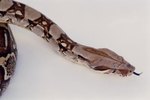Wee pinky rats -- young rats less than a week old -- get their name from their pink, hairless skin. The delicate critters need regular care. Bedding material performs the important function of keeping these tiny rats warm whether it's you or Mama Rat who provides care and feeding.
Soft Cloth
Soft cloth, such as old tee shirt material or flannel, provides a warm and absorbent material for pinky rats. If using cloth, make sure the material will not catch pinky rat toenails. Terry cloth is not suitable, for example, because the nubs can irritate rat feet. Cloth that unravels, such as knitwear, is also unsuitable because the material can unravel and catch on a rat's toes.
Wood and Paper
If you lack cloth, try shredded paper -- either commercially shredded newspaper or paper you shredded yourself. The material is soft, warm and fun for rats to use as nesting material. Pressed pellets made from recycled wood or aspen are expensive, but work okay as pinky rat bedding. They absorb waste, biodegrade and may even be composted. They may be scratchy, so are less desirable than cloth.
Materials to Avoid
Cedar and pine shavings used to be popular rat bedding material. These are no longer recommended since they contain fragrances and phenols that may irritate rat respiratory tracts. Do not use processed corn cobs for rat bedding. Not only are corn cobs more expensive and less available than other recommended bedding, they can give young rats a condition called ringtail.
Keeping Pinky Rats Warm
No matter what type of bedding you choose, ensure the rattery temperature keeps your pinkies warm. Keep the rattery between 75 and 90 degrees Fahrenheit. To warm it, place an electric heating pad set to low beneath the cage. Alternately, wrap a hot water bottle in a towel and place this directly in the cage. Keep a thermometer near the cage to record temperatures and adjust the heat as needed.
References
- "Rats: Everything About Purchase, Care, Nutrition, Handling, and Behavior"; Carol Himsel Daly
- Rat & Mouse Club of America: Caring for Orphaned Baby Rats or Mice
- American Fancy Rat & Mouse Association: Caring for Rat & Mouse Orphans
Writer Bio
A successful website writer since 1998, Elton Dunn has demonstrated experience with technology, information retrieval, usability and user experience, social media, cloud computing, and small business needs. Dunn holds a degree from UCSF and formerly worked as professional chef. Dunn has ghostwritten thousands of blog posts, newsletter articles, website copy, press releases and product descriptions. He specializes in developing informational articles on topics including food, nutrition, fitness, health and pets.





